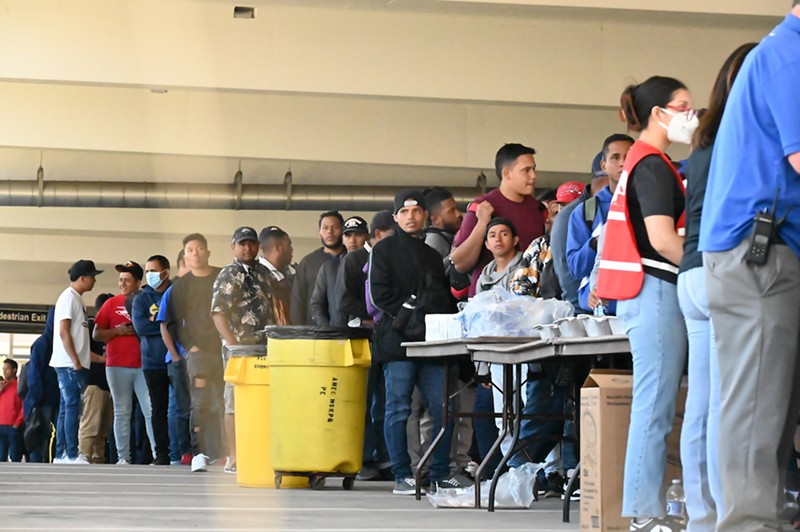"We were just getting busloads of people," recounts the former Michael Hancock chief of staff. "The governor of Texas would issue some kind of a statement playing politics with it. There was no coordination. ... Sometimes you'd get the heads-up. Sometimes you wouldn't."
Since that first week of December last year, nearly 30,000 more migrants have poured into the Mile High City from the U.S. southern border — with Texas continuing to bus them here directly, according to Denver officials.
"We've been doing it for a year, and we're tired," says Jon Ewing, spokesperson for the Denver Mass Care Department Operations Center. "We're trying to provide what we can with what we have. We have limited funding, we have limited resources, but we've been going for a year now. It's not required, but they're coming here, they're asking for help, Texas is busing them here, and we've tried to treat them like human beings."
Just this week, a "ghost bus" dropped off over 100 migrants at the Colorado State Capitol. The term "ghost bus" is used to describe buses that arrive unannounced and without any known origin. The migrants arrived Monday, December 4, and were placed into city-provided housing or offered transportation to another location, along with a group that arrived in Denver on Tuesday, December 5, that included 103 people.
"I was hoping for the city's sake and for the new administration's sake that they wouldn't have this challenge continue, but it has," Salazar says. "I expect we'll have more of this until we can get comprehensive immigration reform through congress."
December 6 marks exactly one year since Denver opened its emergency migrant shelter in response to the first busload of migrants that arrived. The city declared a state of emergency on December 15 as the situation worsened before eventually evolving and adapting "over time" to the influx, Ewing says.
Things appeared to be under control for several months, with migrant numbers waning in different parts of the year but constantly jumping back up.
"I thought we were over the worst back in March," Salazar says. "And then, of course, the numbers kicked back up."

About a dozen migrants flock around a truck that stopped by the encampment at West 27th Avenue to hand out tacos.
Bennito L. Kelty
"We primarily use hotels," Ewing says. "We have staff working [them], we have a whole litany of nonprofits that we work with to provide support. We have dashboards and databases that we didn't have a year ago, so it's evolved in many ways, and we're still providing that support. We're trying to get people out of the cold now."
It's unclear how many buses of migrants, exactly, have been chartered to Denver since December 2022, but in the past six months alone, Ewing knows of more than 200 that have come in directly from Texas.
"It's a lot," he says. "There could be any number of people on those buses."
Ewing tells Westword that groups have arrived "from all over" this year, but the Lone Star State has sent Colorado more migrants than anywhere else. For the most part, they're being chartered by the Texas state government, but some have been sent by municipal leaders in places like Eagle's Pass, Brownsville and El Paso, according to Ewing.
"Those cities, they've been overwhelmed in many regards," he says. "So they've been getting people up to Denver because there's at least some level of support. They're overwhelmed; they're much smaller than we are."
The Webb Municipal Office Building at 201 West Colfax Avenue is "the most common place that you'll see migrants dropped off at," Ewing says, which he finds frustrating, because it's not a shelter (though it was once used as a processing center). Dropping migrants off there ultimately forces the city to have to shuttle them to shelters, sometimes at odd hours.
"It's a longstanding challenge I think we're going to have to live with, unfortunately," Salazar says.
When the first busload of migrants came a year ago, the city set out cots for them at a recreation center. "It started off in rec centers and things along those lines," Ewing remembers. "We've been utilizing hotels for the last several months."
The city is now relying on at least five shelters to house the migrants — four in Denver and one in Aurora near East Mississippi Avenue and Interstate 225 — that are converted hotels or motels. Likely the most well-known one in Denver is the former Quality Inn at 2601 Zuni Street, where an encampment of several dozen migrants has sprung up just outside of it.
The city doesn't share the location of migrant shelters for safety reasons, Ewing says. It does know about two other migrant encampments, but Ewing wasn't sure about their location.
Denver has spent more than $33 million trying to house, feed and find services for migrants or send them to a second destination. "A lot of times people come up, and they never even wanted to come to Denver," Ewing says. "That's why we end up buying tickets for people to get to other places."
About a hundred migrants have been arriving nearly every day via buses since early December 2022. It's gotten to the point where a "bus arrival is nothing surprising," Ewing says.
"Buses arrive every day," he tells Westword. "We've asked Texas, which is chartering these bus companies, we've asked them multiple times, 'Can you just drop people off at a shelter? Could you just do that?' And you know, it's one thing when it's happening in the daytime. It's another thing when they're dropping people off in the middle of the night nowhere near a shelter."

Manuel Salazar, front, and Carlos Majano cut hair as part of a pop-up barbershop set up on Sunday, November 12, by a member of the Highland Mommies.
Bennito L. Kelty
"Near Zuni, we know about that one, and we've got the outreach teams out there, we've got the port-a-johns out there, we're still communicating with them — and then obviously, when it's cold, we encourage people to come in. We activate the shelter plan so we have the extra space," Ewing says. "They are not forgotten. We have not overlooked them."
Currently, more than 2,700 migrants are staying in shelters in Denver. If they can't find housing once they're forced out, they become one of the more than 9,000 homeless individuals in the Denver metro area, a population tallied by the most recent Point in Time count.
The main challenge for the city right now, Ewing says, is "work authorization," with a lot of the migrants not being authorized to work by the federal government. "It's limited," he explains. "We need to expand the work authorization to get people to work. How do you take care of yourself if you can't work?"
Salazar remembers that last December, young men staying at the city's rec centers told him they were willing to take on any kind of work the city could offer at that moment. "They said, 'Listen, we'll do anything. You're taking care of us,'" he recalls. "'Can we shovel snow? Can we do something?' And I remember asking the city attorney if there was any possibility of employing people even to help work at the rec center, and, of course, federal law prohibits that. I always felt that was an absurdity of the system."
Ewing adds, "The end goal should not be staying in a shelter. The end goal should be trying to make a life for yourself, so we're trying to help them in any way possible."
The City of Denver, specifically, tries to get families with kids off the streets first, Ewing notes, even if shelters are packed.
"We're actively encouraging anyone with children, please come inside," he says. "We'll find space. We'll make space to get you back inside."
The Denver community, meanwhile, has been eager to help: In addition to groups like Highland Mommies, who have organized gift drives and pop-up barbershops to bring in donations, he's heard stories of people taking migrants into their home and of at least one person who drove a family down to Colorado Springs to get them into a shelter.
"It's been remarkable to watch the community support," he says. "The community has stepped up in a big way, especially recently, so we're thankful for that."
Salazar says this was true when the Hancock administration was trying to handle the situation, too. "That's the heartwarming part," Salazar says. "For the most part, the people of Denver were open-hearted, and the volunteer effort was tremendous. People want to help."
The City of Denver is hosting a holiday gift drive for the migrant center until December 18; donations can be dropped off at both the Webb Building and the Taylor Municipal Building, at 4685 Peoria Street, Suite 251.
On Friday, December 8, the city will host a one-day hiring event at the Webb Building to find bilingual staff to work in shelters. Two interview and hiring sessions will be held from 8 a.m. to 12 p.m. and from 1 p.m. to 5 p.m. "The city’s most significant need is staff to support the shelter and resource navigation operations," according to an official statement.
As for next year, Ewing expects that "we'll need substantially more funding" — something Mayor Mike Johnston already requested when he paid a visit to Washington, D.C., in November alongside other mayors whose cities have been impacted by migrants being bused there. Together the coalition requested $1.4 billion for "food, shelter and services" for migrants, according to a letter addressed to President Joe Biden.
"We have limited space, we have limited staffing," Ewing says. "We continue to call for more funding. If we had more funding, we could do more. We're limited where we're at."
"I don't think we're out of the woods with any of this," Salazar says. "My hope is that better angels will prevail, that the politics in Washington will accommodate some changes, because cities can't solve this problem on their own."












